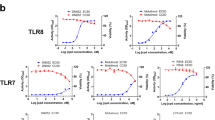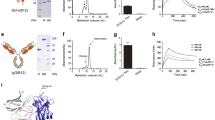Abstract
With the great success of anti-CTLA-4 and anti-PD-1 therapeutics in cancer immunotherapy, tumor necrosis factor receptor superfamily members have been recognized as ideal targets to provide co-stimulatory signals in combination with immune checkpoint blocking antibodies. Among these is OX40 (CD134), a co-stimulatory molecule expressed by activated immune cells. Recently, several anti-OX40 agonistic monoclonal antibodies, pogalizumab as the most advanced, have entered early phase clinical trials. Using a yeast platform and multiple screening methods, we identified a fully human anti-OX40 antibody (IBI101) with distinct modes of action. Unlike pogalizumab, IBI101 partially blocks the binding of OX40 to its ligand OX40L and exhibits both FcγR-dependent and independent agonistic activities in NF-κB luciferase reporter assays. IBI101 also promotes T cell activation and proliferation in vitro. These unique properties partially explain the more potent anti-tumor activity of IBI101 than that of pogalizumab in humanized NOG mice bearing LoVo tumors. In addition, IBI101 shows efficacious anti-tumor activity in mice when administrated alone or in combination with anti-PD-1 antibodies. In human OX40 knock-in mice bearing MC38 colon carcinoma, IBI101 treatment induces tumor antigen-specific CD8+ T-cell responses, decreases immunosuppressive regulatory T cells in tumor, and enhances the immune response to PD-1 inhibition. Preclinical studies of IBI101 in non-human primates demonstrate typical pharmacokinetic characteristics of an IgG antibody and no drug-related toxicity. Collectively, IBI101 has desirable preclinical attributes which support its clinical development for cancer treatment.





Similar content being viewed by others
Abbreviations
- IBI101:
-
A fully human anti-OX40 antibody
- ATCC:
-
American type culture collection
- OX40L:
-
CD252 or OX40 ligand
- IL-2:
-
Interleukin 2
- NF-κB:
-
Nuclear factor (NF)-kappaB
- POGA:
-
Pogalizumab
- TNFR Family:
-
The tumor necrosis factor receptor family
- Teff:
-
T effector cells
References
Ribas A, Wolchok JD (2018) Cancer immunotherapy using checkpoint blockade. Science 359:1350–1355. https://doi.org/10.1126/science.aar4060
Wei SC, Duffy CR, Allison JP (2018) Fundamental mechanisms of immune checkpoint blockade therapy. Cancer Discov 8:1069–1086. https://doi.org/10.1158/2159-8290.CD-18-0367
Chen DS, Mellman I (2013) Oncology meets immunology: the cancer-immunity cycle. Immunity 39:1–10. https://doi.org/10.1016/j.immuni.2013.07.012
Swart M, Verbrugge I, Beltman JB (2016) Combination approaches with immune-checkpoint blockade in cancer therapy. Front Oncol 6:233. https://doi.org/10.3389/fonc.2016.00233
Sharma P, Allison JP (2015) The future of immune checkpoint therapy. Science 348:56–61. https://doi.org/10.1126/science.aaa8172
Chen DS, Mellman I (2017) Elements of cancer immunity and the cancer-immune set point. Nature 541:321–330. https://doi.org/10.1038/nature21349
Ward-Kavanagh LK, Lin WW, Sedy JR, Ware CF (2016) The TNF receptor superfamily in co-stimulating and co-inhibitory responses. Immunity 44:1005–1019. https://doi.org/10.1016/j.immuni.2016.04.019
Sugamura K, Ishii N, Weinberg AD (2004) Therapeutic targeting of the effector T-cell co-stimulatory molecule OX40. Nat Rev Immunol 4:420–431. https://doi.org/10.1038/nri1371
Buchan SL, Rogel A, Al-Shamkhani A (2018) The immunobiology of CD27 and OX40 and their potential as targets for cancer immunotherapy. Blood 131:39–48. https://doi.org/10.1182/blood-2017-07-741025
Croft M (2010) Control of immunity by the TNFR-related molecule OX40 (CD134). Annu Rev Immunol 28:57–78. https://doi.org/10.1146/annurev-immunol-030409-101243
Jacquemin C, Augusto JF, Scherlinger M et al (2018) OX40L/OX40 axis impairs follicular and natural Treg function in human SLE. JCI Insight. https://doi.org/10.1172/jci.insight.122167
Vanamee ES, Faustman DL (2018) Structural principles of tumor necrosis factor superfamily signaling. Sci Signal. https://doi.org/10.1126/scisignal.aao4910
Aspeslagh S, Postel-Vinay S, Rusakiewicz S, Soria JC, Zitvogel L, Marabelle A (2016) Rationale for anti-OX40 cancer immunotherapy. Eur J Cancer 52:50–66. https://doi.org/10.1016/j.ejca.2015.08.021
Vu MD, Xiao X, Gao W, Degauque N, Chen M, Kroemer A, Killeen N, Ishii N, Li XC (2007) OX40 costimulation turns off Foxp3+ Tregs. Blood 110:2501–2510. https://doi.org/10.1182/blood-2007-01-070748
Kitamura N, Murata S, Ueki T, Mekata E, Reilly RT, Jaffee EM, Tani T (2009) OX40 costimulation can abrogate Foxp3+ regulatory T cell-mediated suppression of antitumor immunity. Int J Cancer 125:630–638. https://doi.org/10.1002/ijc.24435
Xiao X, Kroemer A, Gao W, Ishii N, Demirci G, Li XC (2008) OX40/OX40L costimulation affects induction of Foxp3+ regulatory T cells in part by expanding memory T cells in vivo. J Immunol 181:3193–3201
Compaan DM, Hymowitz SG (2006) The crystal structure of the costimulatory OX40–OX40L complex. Structure 14:1321–1330. https://doi.org/10.1016/j.str.2006.06.015
Morris NP, Peters C, Montler R, Hu HM, Curti BD, Urba WJ, Weinberg AD (2007) Development and characterization of recombinant human Fc:OX40L fusion protein linked via a coiled-coil trimerization domain. Mol Immunol 44:3112–3121. https://doi.org/10.1016/j.molimm.2007.02.004
Oberst MD, Auge C, Morris C et al (2018) Potent immune modulation by MEDI6383, an engineered human OX40 ligand IgG4P Fc fusion protein. Mol Cancer Ther 17:1024–1038. https://doi.org/10.1158/1535-7163.MCT-17-0200
Marin-Acevedo JA, Dholaria B, Soyano AE, Knutson KL, Chumsri S, Lou Y (2018) Next generation of immune checkpoint therapy in cancer: new developments and challenges. J Hematol Oncol 11:39. https://doi.org/10.1186/s13045-018-0582-8
Ueno H, Blanco P (2015) OX40/OX40L axis: not a friend in autoimmunity. Oncotarget 6:21779–21780. https://doi.org/10.18632/oncotarget.4973
Zhang D, Armstrong AA, Tam SH, McCarthy SG, Luo J, Gilliland GL, Chiu ML (2017) Functional optimization of agonistic antibodies to OX40 receptor with novel Fc mutations to promote antibody multimerization. MAbs 9:1129–1142. https://doi.org/10.1080/19420862.2017.1358838
Dahan R, Barnhart BC, Li F, Yamniuk AP, Korman AJ, Ravetch JV (2016) Therapeutic activity of agonistic, human anti-CD40 monoclonal antibodies requires selective FcgammaR engagement. Cancer Cell 29:820–831. https://doi.org/10.1016/j.ccell.2016.05.001
White AL, Chan HT, French RR et al (2015) Conformation of the human immunoglobulin G2 hinge imparts superagonistic properties to immunostimulatory anticancer antibodies. Cancer Cell 27:138–148. https://doi.org/10.1016/j.ccell.2014.11.001
Curti BD, Kovacsovics-Bankowski M, Morris N et al (2013) OX40 is a potent immune-stimulating target in late-stage cancer patients. Cancer Res 73:7189–7198. https://doi.org/10.1158/0008-5472.CAN-12-4174
Zhang X, Xiao X, Lan P et al (2018) OX40 costimulation inhibits Foxp3 expression and Treg induction via BATF3-dependent and independent mechanisms. Cell Rep 24:607–618. https://doi.org/10.1016/j.celrep.2018.06.052
Marabelle A, Kohrt H, Sagiv-Barfi I et al (2013) Depleting tumor-specific Tregs at a single site eradicates disseminated tumors. J Clin Investig 123:2447–2463. https://doi.org/10.1172/JCI64859
Bulliard Y, Jolicoeur R, Zhang J, Dranoff G, Wilson NS, Brogdon JL (2014) OX40 engagement depletes intratumoral Tregs via activating FcgammaRs, leading to antitumor efficacy. Immunol Cell Biol 92:475–480. https://doi.org/10.1038/icb.2014.26
Acknowledgements
The authors would like to thank Dr. Pu Pu and Dr. Siyi Hu for their helpful suggestions during manuscript preparation.
Funding
This study was supported by the National Key Research and Development Program of China (2017YFC0909801).
Author information
Authors and Affiliations
Contributions
HJ, BC, MY, and JL designed the study; ZK, HN, ZW, SZ and YL performed the in vitro experiments; JW, MW, PZ and WW performed the experiment in rodent, XQ and DW performed the experiment in primate. BP and HB provided the yeast platform. HJ and ZK wrote the manuscript. All authors read and approved the final manuscript.
Corresponding author
Ethics declarations
Conflict of interest
Bianka Prinz and Hemanta Baruah have no potential conflicts of interest to disclose. All other authors are employees of Innovent Biologics (Suzhou).
Ethical approval and ethical standards
All mice experiments were performed in accordance with regulations for care and use of laboratory animals at Innovent Biologics and were approved by Innovent’s Institutional Animal Care and Use Committee (IACUC-01). All monkey experiments were approved by IACUC and performed according to the regulation of AAALAC.
Animal source
NOG mice were purchased from Beijing Vital River Laboratory Animal Technology Co. (Beijing, China). OX40 knock in mice were purchased from Shanghai Model organisms (Shanghai, China). Cynomolgus monkey were purchased from Beijing Prima Biotech Inc.
Cell line authentication
RAJI, Jurkat, HEK293 and Lovo cell lines were obtained from ATCC (Manassas, VA). CHO-S cell line was obtained from Themo Fisher Scientific, Carlsbad, CA, USA). MC38 cell line was obtained from Shanghai Model Organisms Center, Inc. (Shanghai, China). Peripheral Blood Mononuclear Cells cells were purchased from Allcells (Alameda, CA, USA).
Additional information
Publisher's Note
Springer Nature remains neutral with regard to jurisdictional claims in published maps and institutional affiliations.
Electronic supplementary material
Below is the link to the electronic supplementary material.
Rights and permissions
About this article
Cite this article
Kuang, Z., Jing, H., Wu, Z. et al. Development and characterization of a novel anti-OX40 antibody for potent immune activation. Cancer Immunol Immunother 69, 939–950 (2020). https://doi.org/10.1007/s00262-020-02501-2
Received:
Accepted:
Published:
Issue Date:
DOI: https://doi.org/10.1007/s00262-020-02501-2




